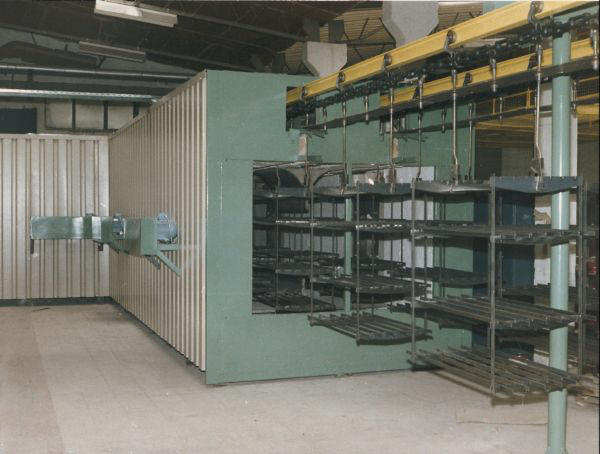Benefit from our knowledge & experience !
Industrial Enameling Furnace Technology
Concept Engineering & Performance Optimizing
Introduction
Firing is a critical step at every enameling process and each enameling plant has at least one enameling furnace.
Our staff has many years of experience with the design, installation and maintenance of industrial enameling furnaces and may assist you to
Select the most suitable furnaceExtend its lifetime
Improve its performance
Reduce total cost of ownership
Source critical spare parts

Introduction
Curing or firing a porcelain enameling coating is done inside high temperature furnaces.
In the early days these furnaces were made of refractory bricks, due to the required firing temperature between 800 and 850 degrees Celsius.
However, such bricks are sensitive for thermal shocks and need to be heated up & cooled down very slowly.
Therefore modern enamelling furnaces are nowadays made of Low Thermal Mass insulation materials, like stone wool, vermiculite & ceramic fibers.
The possibility to switch off a LTM furnace at the end of the day and heat it up again within 1 hour the next morning may provide significant annual energy savings upto 75 % in comparison with the old brick-lined furnaces.
Read more...Major furnace components
An industrial continuous enameling furnace consist typically of the following components:
- Steel structure
- Insulation materials
- Heating system
- Heat resisting alloy
- Air sealing
- Electrical controls
- Furnace conveyor
- Auxiliary furnace equipment
Read more...
About Us
We assist manufacturers within the porcelain/vitreous enameling industry with
- designing industrial enameling furnaces
- building industrial enameling furnaces
- optimizing industrial enameling furnaces
- troubleshooting industrial enameling furnaces
- sourcing critical spare parts
- maintaining industrial enameling furnaces
- converting industrial enameling furnaces
- extending industrial enameling furnaces
- relocating industrial enameling furnaces
- renovating industrial enameling furnaces
Contact us for more information and/or support
Furnace atmosphere
A clean furnace atmosphere is important for obtaining good enameling results.
Elevated concentrations of CO2 and/or H2O may slow down the emission of gases from the metal substrate thru the enamel layer during the fusion stage and under certain unfavorable circumstances result in enameling defects such as pinholes & fish-scales.
During the fusion of the enamel layer, fluorine is released.
This fluorine may react with water vapor, which is present inside the furnace and the resulting HF vapors may jeopardize furnace components made of heat resisting alloy (such as air-seals, heating elements and/or radiant tubes) and the furnace insulation.
Read more...Energy consumption & savings
Enamel furnaces are typically the single biggest energy consumer within an industrial porcelain enameling plant, because they require considerable quantities of gas, oil and/or electricity during both daily start-up and operation.
The lowest possible energy consumption of an enamel furnace is achieved by :
- selecting the most efficient furnace technology
- determine the right furnace size
- maintaining the furnace in a good condition by regularly performing preventive maintenance.
Read more...
Spare parts
We may assist with sourcing critical spare parts for various enameling furnaces
Spare parts for Ferro furnacesSpare parts for Smit Ovens furnaces
Spare parts for Smit Sinus furnaces
Spare parts for AEE / AES furnaces
Benefit from our experience
Our Managing Director & Owner has been personally involved in 50+ industrial porcelain enameling projects since 1984, while working respectively for Ferro (Holland) BV, Smit Ovens BV, Smit Sinus Enameling BV, Nordson Corporation and/or Ditmer Trading & Consulting BV.
Click here for our reference list
Company details
Ditmer Trading & Consulting BV
Palissander 141
3315MP Dordrecht
The Netherlands
Phone :
+31-78-6169877
e-mail : info@ditmer.nl
Palissander 141, 3315 MP Dordrecht, The Netherlands | e-mail: info@ditmer.nl | Phone : +31-786169877 | WhatsApp : +31-638-508743
